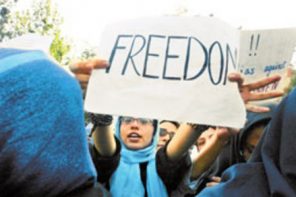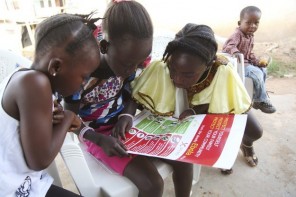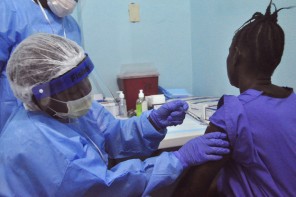Some of you might remember my series on grassroots reconciliation in Sierra Leone. Fambul Tok is a local program in every sense–started by a Sierra Leonean, run by Sierra Leoneans, and welcomed by villages that want to use their traditional culture to help overcome the legacy of war. It’s not a requirement of the UN, or an NGO. It doesn’t even involve white people.
Except for the documentary. There’s a small, fantastically talented crew documenting the project, gently shepherded by photographer and journalist extraordinaire Sara Terry.
Sara is trying to raise $700, stat, to buy corrugated roofs for two good causes: one is a house being built by a perpetrator for the survivor he beat. The other is for a communal gathering space in what has been a bitterly divided town. Think of what Town Hall used to be in America, and multiply it, and then imagine it in a town split between the Union and the Confederacy, where residents had finally said, “Okay, enough of that Yankee/Rebel business, let’s get this place in shape.”
Read about these stories below, and if you’re interested in contributing, get in touch with me ASAP: jinamoore at gmail dot com. Sara leaves May 18. So that’s our deadline. Go.
From Sara Terry:
The rebels captured both Sahr and Nyumah – and forced Nyumah to beat his best friend so severely that Sahr still can’t walk without great difficulty today. The days surrounding the confession, forgiveness and cleansing ceremonies– and the visits I have made with them since – are among the most incredible experiences I’ve had in thirty years as a journalist. The depth of their friendship – their joy at its renewal, the tenderness between them – is breathtaking. Nyumah, whose village is a mile away from Sahr’s, climbs up over the mountain between them every few days to visit his friend – and to help him work on his farm. I last saw the two of them in January, and learned that Nyumah wants to build a house for his friend. He can make the bricks and construct the house on his own — with help from the community, which has been completely supportive of the renewed friendship – but he can’t afford the money for the crucial element: a zinc roof.
The cost of the zinc roof for the house that Nyumah wants to build for Sahr: $400
The second zinc roof story is a story about Daabu, a tiny village of about 60 residents that was split in two during the war – some people fled for refuge in nearby Guinea, while others stayed behind in their village, which became a base for rebel forces. After the war was over, the two groups remained bitterly divided; those who had fled regarded everyone who had stayed as a rebel (despite the fact that most of the villagers were used as forced labor by the rebels).
At one point during the war, the rebels forced the villagers to tear the zinc roofs off their homes – and carry them on their heads to Guinea, where the rebels sold the zinc and kept the money. At the end of the war, villagers rummaged in the bush and found bits and pieces of zinc remnants – and made patchwork roofs for the small mud houses they live in today.
At the Fambul Tok ceremonies which took place in Daabu in March, there was an outpouring of emotion – perpetrators sprang up to apologize, without hesitation, for everything from theft to killing. Victims told their own stories, stood next to their offenders, surrounded by the community, and forgave those who had wounded them. It was another remarkable night of witnessing Fambul Tok in action.
One of the most dramatic moments came when a man from a nearby village stood up to confess that he was the one who had torn down the village’s “court barrie” – a small open-air mud-brick structure, covered by a zinc roof, where village business is conducted by the community. These meeting places are very important, culturally and socially, throughout Sierra Leone. Daabu has not had the resources to rebuild its court barrie since the end of the war; there is a foundation, a raised space about two feet high, that stands in the middle of the village, a reminder of where the court barrie once stood. At the bonfire, when this man stood up to apologize, and to explain that the rebels had forced him to tear down the court barrie and carry away the zinc roof to be sold, there was an uproar – people cried out; one man yelled, “I knew you were responsible”; and the village chief took a pretty good right-handed swing at the offender (for which the chief later sheepishly apologized – “I was a little emotional,” he admitted).
The film crew and I fell in love with Daabu and the villagers, who are finding new ways to work together as they continue building on the reconciliation that began around the Fambul Tok bonfire. They are helping each other again, working together, and have even cleared a huge tract of land to build a community farm for the benefit of everyone.
The one thing they really want now is their court barrie. They have the manpower to rebuild it, and the villagers – both perpetrators and victims — are ready to work together to do it. But they don’t have the money for the zinc roof. Building a mud-brick structure, with no roof to protect it from the rains, would be a waste of time and effort – the rains would wash it away.
The cost of a zinc roof for Daabu’s court barrie: $300
Both Sahr and Nyumah, and the villagers of Daabu are going to be in the documentary film I’ve been working on, about Fambul Tok. I think you’ll love these people as much as I do when you see them on the screen. In the meantime, though, I can’t tell you how much your contribution – even just $10 — to this effort would mean. I’m attaching a picture of Sahr and Nyumah, taken on the mountain between their villages, just a few days after they participated in the Fambul Tok bonfire and reconciliation ceremonies. It says a lot about what is possible.




sign me up…. did i miss a link to contribute?
am looking for people who can assist me to build a home for children with hiv in zimbabwe, i have already paid for the land to build on